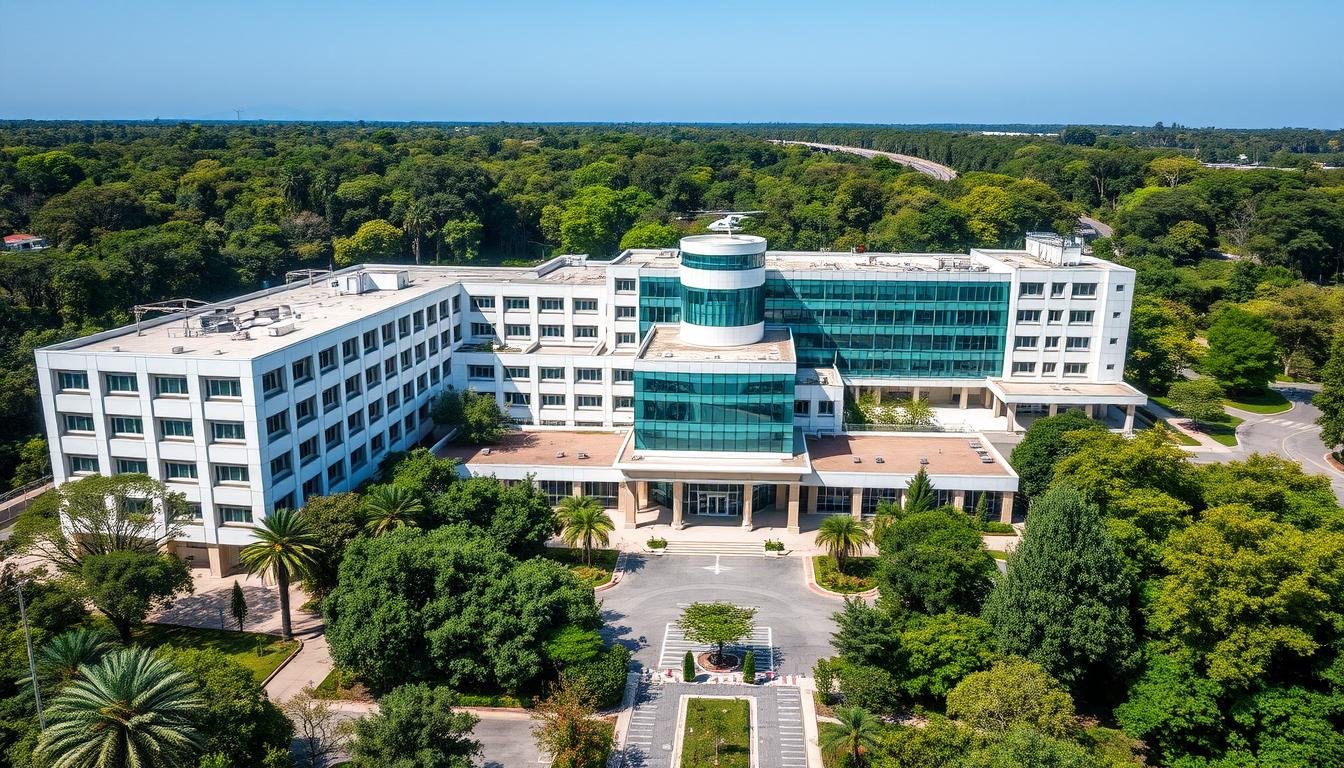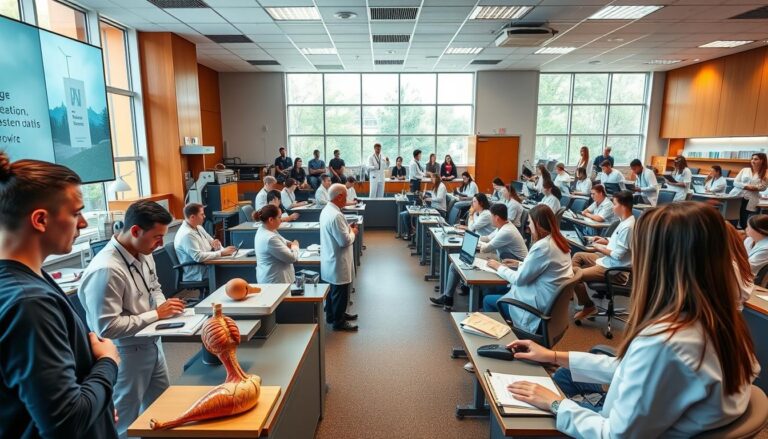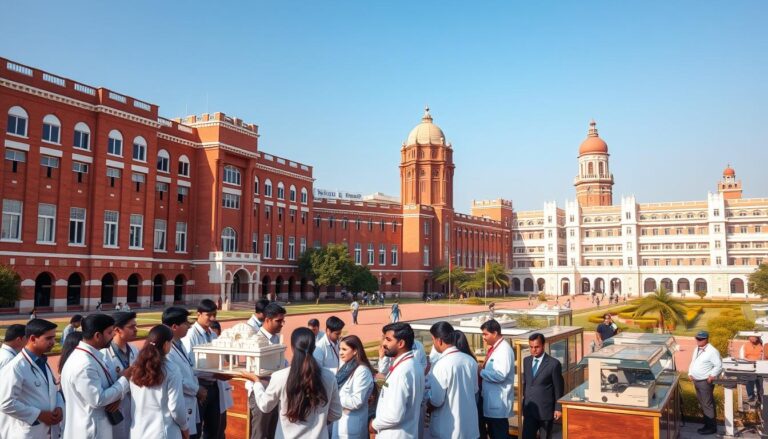What makes a medical institution stand out in a country known for its world-class education and advanced healthcare systems? The answer lies in its infrastructure and the quality of clinical training it offers. In India, the reputation of an institution often hinges on its ability to provide students with hands-on experience in top-tier facilities.
When choosing a place to study, the quality of hospital facilities plays a crucial role. These facilities directly impact the learning experience and prepare students for real-world challenges. Institutions like AIIMS Delhi and Christian Medical College Vellore are prime examples of how advanced infrastructure can shape future healthcare professionals.
This article explores institutions recognized for their superior infrastructure, as highlighted by NIRF rankings and India Today’s 2024 list. Whether you’re considering government or private options, we aim to guide you in making an informed decision.
Introduction to India’s Premier Medical Colleges
India’s educational landscape is enriched by over 600 institutions dedicated to shaping future healthcare professionals. These establishments offer programs in MBBS, nursing, and paramedical fields, catering to diverse career aspirations. The National Eligibility cum Entrance Test (NEET UG) serves as the gateway for admissions, ensuring a standardized selection process across both government and private institutions.
When it comes to affordability, government institutions stand out with annual fees as low as ₹7,000. In contrast, private institutions can charge up to ₹25 lakhs per year. Despite the cost difference, both types of institutions aim to provide quality education and hands-on training.
Key factors like faculty expertise, research contributions, and global affiliations set top institutions apart. For instance, AIIMS Delhi, Christian Medical College Vellore, and Maulana Azad Medical College are renowned for their excellence in medical education and infrastructure. These institutions serve as benchmarks, inspiring others to elevate their standards.
With a focus on holistic development, India’s premier institutions continue to produce skilled professionals ready to tackle global healthcare challenges. Their commitment to innovation and patient care ensures a bright future for the country’s healthcare system.
Top Medical Colleges in India with the Best Hospital Facilities
Hands-on experience in advanced settings is a hallmark of top-tier institutions. These establishments not only provide quality education but also equip students with practical skills through state-of-the-art resources. Let’s explore three institutions that stand out for their exceptional infrastructure.
All India Institute of Medical Sciences (AIIMS), New Delhi
Established in 1956, AIIMS New Delhi is a pioneer in medical innovation. It offers UG, PG, and doctoral programs, ensuring comprehensive learning. With over 2,500 beds, robotic surgery units, and AI-driven diagnostics, the institution is a leader in advanced healthcare solutions.
AIIMS boasts a 97% placement rate, reflecting its commitment to student success. Its trauma center is one of the most advanced in the country, providing students with unparalleled practical experience.
Jawaharlal Institute of Postgraduate Medical Education and Research (JIPMER), Puducherry
Founded in 1823, JIPMER operates autonomously under the Health Ministry. It conducts its own entrance exams and offers a 1,700-bed hospital with rare disease research centers. The institution emphasizes innovation, with ₹1.2 crore allocated annually for research funding.
JIPMER’s sprawling campus and advanced facilities make it a preferred choice for aspiring healthcare professionals. Its focus on rare diseases and specialized care sets it apart.
Christian Medical College (CMC), Vellore
CMC Vellore, though private, is government-supported and emphasizes community healthcare. Its 2,800-bed facility offers subsidized care and telemedicine services, ensuring accessibility for all. The institution’s rural healthcare network provides students with unique learning opportunities.
CMC’s commitment to affordable care and advanced training makes it a standout choice for those passionate about community health.
- AIIMS: Advanced trauma center and AI-driven diagnostics.
- JIPMER: Rare disease research and annual research funding.
- CMC Vellore: Subsidized care and rural healthcare network.
Why Hospital Infrastructure Matters in Medical Education
The foundation of effective learning in healthcare lies in robust infrastructure. Advanced ICUs and surgical units provide students with hands-on learning opportunities. These resources are essential for mastering complex procedures and understanding patient care in real-world settings.
24/7 emergency wards prepare students for real-world crises. Exposure to high-pressure environments ensures they develop the skills needed to handle emergencies confidently. This practical experience is invaluable in shaping competent healthcare professionals.
KGMU Lucknow’s hybrid OT theaters are a prime example of innovation. These theaters have reduced infection rates by 40%, showcasing how advanced facilities can improve patient outcomes. Such environments also offer students a chance to learn cutting-edge techniques.
Simulation labs play a crucial role in minimizing training errors. These labs allow students to practice procedures in a controlled setting, building confidence before they work with actual patients. This approach ensures safer and more effective learning.
High patient volume, like Safdarjung Hospital’s 10,000+ daily OPD cases, provides unmatched exposure. Students gain experience in managing diverse cases, preparing them for the demands of their future careers. This hands-on training is a cornerstone of quality medical education.
- Advanced ICUs and surgical units enhance practical learning.
- 24/7 emergency wards prepare students for real-world challenges.
- Hybrid OT theaters reduce infection rates and teach innovative techniques.
- Simulation labs minimize errors and build confidence.
- High patient volume offers diverse learning opportunities.
Government Medical Colleges Leading in Infrastructure
Government institutions in India are setting benchmarks in healthcare education through their advanced infrastructure. These establishments not only provide quality education but also ensure students gain hands-on experience in state-of-the-art facilities. Let’s explore three such institutions that stand out for their exceptional resources and training programs.
Armed Forces Medical College (AFMC), Pune
Managed by the Indian Armed Forces, AFMC Pune is a premier institution offering stipends to its students. It features military-grade trauma simulation centers and specialized battlefield medicine programs. With a 100% placement rate in armed forces hospitals, AFMC ensures its graduates are well-prepared for real-world challenges.
Maulana Azad Medical College (MAMC), New Delhi
Affiliated with Delhi University, MAMC is attached to Lok Nayak Hospital, a 1,900-bed facility. The institution boasts a dedicated burns unit and an organ transplant wing. With an annual infrastructure development fund of ₹85 crore, MAMC continues to enhance its resources for better learning outcomes.
King George’s Medical University (KGMU), Lucknow
Founded in 1911, KGMU offers super-specialty courses and features a 3,000-bed facility. Its virology lab played a crucial role in COVID-19 research, showcasing its commitment to innovation. KGMU’s advanced infrastructure ensures students receive comprehensive training in diverse healthcare scenarios.
| Institution | Key Features |
|---|---|
| AFMC Pune | Military-grade trauma centers, battlefield medicine, 100% placement |
| MAMC Delhi | 1,900-bed hospital, burns unit, organ transplant wing, ₹85 crore fund |
| KGMU Lucknow | 3,000-bed facility, virology lab, super-specialty courses |
Private Medical Colleges with State-of-the-Art Facilities
Private institutions in India are redefining healthcare education with cutting-edge technology and innovative learning environments. These establishments combine advanced resources with practical training to prepare students for real-world challenges. Let’s explore two leading private institutions that stand out for their exceptional infrastructure.

Kasturba Medical College, Manipal
Kasturba Medical College, a deemed university, is a pioneer in integrating technology into education. It features VR-based anatomy labs and AI-powered patient monitoring systems, offering students a futuristic learning experience. With 12 specialty clinics attracting international patients, the institution ensures exposure to diverse healthcare scenarios.
While the annual fee of ₹18 lakh is higher compared to government institutions like AIIMS, the investment is justified by its advanced resources and global recognition. Kasturba’s focus on innovation and patient care makes it a top choice for aspiring healthcare professionals.
Dr. MGR Educational and Research Institute, Chennai
Dr. MGR Educational and Research Institute is another deemed university known for its commitment to affordable healthcare. Its Chennai hospital boasts 330 beds, 4 advanced OTs, and 24/7 lab services. The institution also offers free healthcare initiatives, ensuring accessibility for all.
With specialized pediatric surgery units and NICU/PICU wards, Dr. MGR provides comprehensive training in critical care. Its partnership with Johns Hopkins for surgical training further enhances its reputation as a leader in healthcare education.
- Kasturba Manipal: VR labs, AI monitoring, and 12 specialty clinics.
- Dr. MGR Chennai: Free healthcare, pediatric units, and global partnerships.
- Fee Comparison: Kasturba’s ₹18 lakh/year vs. AIIMS’s ₹2,000/year.
Key Features of Top-Tier Medical College Hospitals
Top-tier institutions in India are setting new standards in healthcare education through advanced infrastructure and global collaborations. These establishments focus on innovation, specialized training, and cutting-edge research to prepare students for real-world challenges.
Advanced Research Centers
Leading institutions like AIIMS Delhi and CMC Vellore are at the forefront of medical research. AIIMS collaborates with Harvard Medical School for oncology research and operates a nano-medicine lab developing targeted cancer therapies. CMC Vellore’s hybrid operating rooms enable real-time MRI-guided surgeries, enhancing precision and outcomes.
Specialized ICUs and Surgical Units
Specialized units are a hallmark of top institutions. AFMC Pune conducts aerospace medicine research, focusing on the health challenges faced by fighter pilots. KGMU Lucknow’s ICMR-funded antimicrobial resistance surveillance unit contributes to critical public health research.
Affiliation with Global Institutions
Global partnerships enhance the quality of education and research. JIPMER collaborates with WHO for public health initiatives, while Kasturba Medical College partners with MIT for advanced research and educational exchanges. These affiliations provide students with exposure to global healthcare standards.
- AIIMS Delhi: Nano-medicine lab and Harvard collaboration for oncology research.
- CMC Vellore: Hybrid ORs for real-time MRI-guided surgeries.
- AFMC Pune: Aerospace medicine research for fighter pilots.
- KGMU Lucknow: ICMR-funded antimicrobial resistance unit.
- Global Partners: JIPMER with WHO, Kasturba with MIT.
How NIRF Rankings Identify the Best Infrastructure
Understanding how institutions are ranked helps us identify those with the strongest infrastructure. The National Institutional Ranking Framework (NIRF) evaluates institutions based on several parameters, with infrastructure carrying a 30% weightage. This includes factors like bed-to-student ratio, OT availability, and digital records systems.
AIIMS Delhi, ranked #1 in NIRF 2024, exemplifies excellence with a 1:4 faculty-student ratio and advanced resources. Its infrastructure supports both education and patient care, making it a benchmark for others. Similarly, JIPMER Puducherry, ranked #3, has contributed significantly through its 12 research journals, enhancing its reputation.
However, not all institutions meet these standards. Around 27% of colleges score below 50/100 in NIRF due to infrastructure gaps. These gaps can hinder student learning and patient care, emphasizing the need for continuous improvement.
UCMS Delhi is a success story in this regard. Its 2023 infrastructure upgrade, including modern OTs and digital systems, boosted its rank by 8 positions. This highlights how targeted investments can transform an institution’s standing.
| Institution | NIRF Rank (2024) | Score |
|---|---|---|
| AIIMS Delhi | 1 | 94.46 |
| JIPMER Puducherry | 3 | 75.11 |
| UCMS Delhi | 32 | 57.65 |
By focusing on these parameters, NIRF helps us recognize institutions that prioritize infrastructure development. This ensures students receive quality education and hands-on training in well-equipped environments.
State-Wise Distribution of Top Medical Colleges
India’s diverse states are home to some of the most renowned institutions in healthcare education. Each region offers unique opportunities for students, combining advanced infrastructure with practical training. Let’s explore how Delhi, Tamil Nadu, and Karnataka stand out in this landscape.
Delhi: A Hub for Medical Excellence
Delhi is a leading hub for healthcare education, hosting 7 NIRF-ranked institutions. AIIMS and MAMC are among the top 10 government colleges in the country. These establishments handle over 48,000 annual OPD cases, providing students with unmatched exposure to diverse healthcare scenarios.
With a focus on innovation and patient care, Delhi’s institutions set benchmarks for others to follow. Their advanced resources and high patient volume ensure comprehensive training for aspiring professionals.
Tamil Nadu and Karnataka’s Leading Institutions
Tamil Nadu is known for its commitment to accessible healthcare. CMC Vellore, with its 65% rural outreach, ensures quality care reaches underserved communities. JIPMER Puducherry complements this with 22 super-specialty departments, offering students a wide range of learning opportunities.
Karnataka, on the other hand, is a pioneer in integrating technology into healthcare. Kasturba Medical College’s 22-acre health campus features drone-based medicine delivery, showcasing its innovative approach. The state also offers a 50% fee waiver for SC/ST students, making education more accessible.
- Delhi: 7 NIRF-ranked colleges, 48,000+ annual OPD capacity.
- Tamil Nadu: CMC Vellore’s rural outreach, JIPMER’s super-specialty departments.
- Karnataka: Kasturba’s tech-driven campus, state subsidies for SC/ST students.
Maharashtra is also making strides, with 14 new institutions approved in 2024. This expansion reflects the growing demand for quality healthcare education across the country. Together, these states contribute significantly to India’s reputation as a leader in medical training.
Admission Process for Colleges with Top Hospital Facilities
Securing admission to top institutions with advanced resources requires a clear understanding of the process. The National Eligibility cum Entrance Test (NEET) is the primary gateway for aspiring students. In 2025, the exam is scheduled for May 5, with over 1.3 million applicants expected to compete for limited seats.
For institutions like AIIMS, the NEET UG cutoff is exceptionally high, with a 99.9 percentile required for the general category. Additionally, AIIMS conducts separate entrance tests for its MD/MS programs, ensuring only the most qualified candidates are selected. This rigorous process highlights the institution’s commitment to excellence in medical education.
JIPMER Puducherry follows a unique pattern with its 200-question MCQ test, differing from NEET’s 180 questions. This approach tests candidates’ depth of knowledge and analytical skills. Both institutions emphasize the importance of scoring well in these exams to secure a seat in their prestigious programs.
Document requirements are another critical aspect of the admission process. Applicants must provide proof of 12th-grade marks with at least 60% in PCB (Physics, Chemistry, Biology). Domicile certificates are also necessary for those applying under state quotas. These documents ensure transparency and fairness in the selection process.
- NEET 2025 Exam Date: May 5, 2025, with 1.3 million expected applicants.
- AIIMS Additional Tests: Separate entrance exams for MD/MS programs.
- JIPMER Pattern: 200-question MCQ test, distinct from NEET.
- Document Requirements: 12th-grade marks (60% PCB), domicile certificates.
- 2024 Cutoff Trends: 720/720 for AIIMS, 650+ for AFMC.
Understanding these requirements and preparing accordingly can significantly improve your chances of securing admission to a government medical college with top-tier facilities. Stay informed and focused to navigate this competitive process successfully.
Comparing Government vs. Private College Infrastructure
When evaluating educational institutions, the infrastructure plays a pivotal role in shaping student experiences. Government and private establishments differ significantly in their resources, budgets, and learning environments. These factors influence not only education quality but also career outcomes for graduates.
Government institutions, on average, have 1,200 beds, providing extensive clinical exposure. In contrast, private colleges typically offer 800 beds. This difference reflects the broader patient diversity in government hospitals, where students encounter three times more complex cases. Such exposure prepares them for real-world challenges in healthcare.
Budget allocation is another key distinction. AIIMS, a leading government institution, operates with an annual budget of ₹4,200 crore. This enables advanced research and infrastructure development. Private colleges like Dr. MGR Educational and Research Institute, with a ₹380 crore budget, focus on faster tech adoption. For instance, 68% of private institutions use robotic surgery, compared to 41% in government setups.
Tuition fees also vary widely. AFMC Pune offers ₹0 tuition, making it accessible to many. Private colleges like Kasturba Medical College charge ₹23 lakh annually. However, the return on investment differs. 92% of government alumni serve in public healthcare, while 55% of private graduates join corporate hospitals.
- Bed Capacity: Government – 1,200 beds; Private – 800 beds.
- Budgets: AIIMS – ₹4,200 crore; Dr. MGR – ₹380 crore.
- Tech Adoption: Robotic surgery in 68% private vs. 41% government institutions.
- Tuition Fees: AFMC – ₹0; Kasturba – ₹23 lakh/year.
- ROI: 92% government alumni in public service; 55% private graduates in corporate hospitals.
Conclusion
Choosing the right institution for healthcare studies involves more than just academic reputation. Institutions like AIIMS, CMC, and JIPMER lead the way with advanced infrastructure and hands-on training opportunities. Their state-of-the-art facilities ensure students gain practical experience in real-world settings.
NIRF rankings are a reliable guide for evaluating these institutions. They highlight key factors like patient exposure and research opportunities, which are crucial for a well-rounded education. Comparing case variety and innovation in training programs can help students make informed decisions.
Resources like the ALLEN App can also play a significant role in NEET preparation, helping aspirants secure admission to top institutions. Finally, visiting campuses to assess OT complexes and ICU technology firsthand can provide valuable insights into the learning environment.





